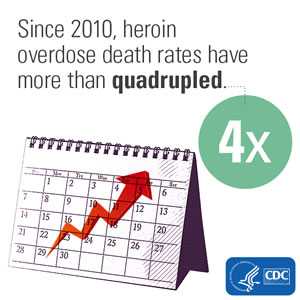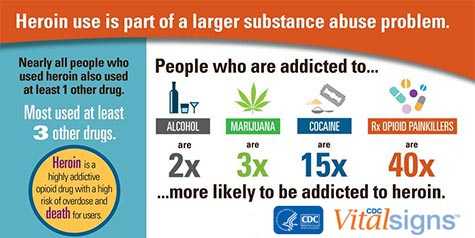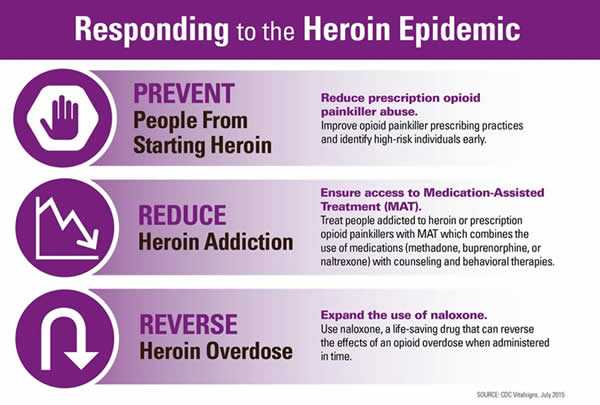Heroin
Today’s Heroin Epidemic
Heroin use has increased sharply across the United States among men and women, most age groups, and all income levels. Some of the greatest increases occurred in demographic groups with historically low rates of heroin use: women, the privately insured, and people with higher incomes.

How is heroin harmful?
- Heroin is an illegal, highly addictive opioid drug.3
- A heroin overdose can cause slow and shallow breathing, coma, and death.3
- People often use heroin along with other drugs or alcohol. This practice is especially dangerous because it increases the risk of overdose.4
- Heroin is typically injected but is also smoked and snorted. When people inject heroin, they are at risk of serious, long-term viral infections such as HIV, Hepatitis C, and Hepatitis B, as well as bacterial infections of the skin, bloodstream, and heart.3
How big is the problem of heroin overdoses? 
Not only are people using heroin, they are also abusing multiple other substances, especially cocaine and prescription opioid pain relievers. Nearly all people who use heroin also use at least 1 other drug.1
As heroin use has increased, so have heroin-related overdose deaths. Between 2000 and 2015, the rate of heroin-related overdose deaths more than quadrupled, and more than 12,989 people died in 2015.2
Who is most at risk of heroin addiction?1 
- People who are addicted to prescription opioid pain relievers
- People who are addicted to cocaine
- People without insurance or enrolled in Medicaid
- Non-Hispanic whites
- Males
- People who are addicted to marijuana and alcohol
- People living in a large metropolitan area
- 18 to 25 year olds

What can be done?
Reduce prescription opioid abuse
Prevent people from starting heroin by reducing prescription opioid abuse
- Improve opioid prescribing practices and help identify individuals at high risk early.5
- Among new heroin users, about three out of four report abusing prescription opioids before using heroin.6
Ensure access to prevention services
Ensure that people have access to integrated prevention services, including access to sterile injection equipment from a reliable source, as allowed by local policy.
Ensure access to Medication-Assisted Treatment
Reduce heroin addiction by ensuring access to Medication-Assisted Treatment (MAT)
- Treat people addicted to heroin or prescription opioids with MAT which combines the use of medications (methadone, buprenorphine, or naltrexone) with counseling and behavioral therapies.5
- People who are addicted to prescription opioids are 40 times more likely to also be addicted to heroin.1
Expand the use of naloxone
Reverse heroin overdose by expanding the use of naloxone
- Use naloxone, a life-saving drug that can reverse the effects of an opioid overdose when administered in time.5
- Heroin overdose deaths more than quadrupled in the United States, 2002–2014.4
Related Pages
- July 2015 CDC Vital Signs Report: Today’s Heroin Epidemic – More People at Risk, Multiple Drugs Abused
- CDC MMWR: Demographic and Substance Use Trends Among Heroin Users — United States, 2002–2013
- Vital Signs – Today’s Heroin Epidemic [PODCAST – 1:15 minutes]
- Vital Signs – Today’s Heroin Epidemic [PSA – 0:60 seconds]
- Data Brief: Drug-poisoning Deaths Involving Heroin: United States, 2000–2013
- Press Release: Heroin overdose deaths increased in many states through 2012
- HIV and Injection Drug Use in the United States
- Hepatitis C & Injection Drug Use
Additional Resources
- National Alliance for Model State Drug Laws: Naloxone Page
- MedlinePlus – Heroin
- Substance Abuse and Mental Health Services Administration (SAMHSA)
- Providers’ Clinical Support System for Medication Assisted Treatment
- Drug Enforcement Administration (DEA): Heroin[145KB]
- National Institute on Drug Abuse (NIDA)
References
- Centers for Disease Control and Prevention. Demographic and Substance Use Trends Among Heroin Users — United States, 2002–2013. MMWR 2015; 64(26):719-725.
- Rudd RA, Seth P, David F, Scholl L. Increases in Drug and Opioid-Involved Overdose Deaths — United States, 2010–2015. MMWR Morb Mortal Wkly Rep. ePub: 16 December 2016. DOI: http://dx.doi.org/10.15585/mmwr.mm6550e1.
- National Institute on Drug Abuse. DrugFacts: Heroin. http://www.drugabuse.gov/publications/drugfacts/heroin.
- Substance Abuse and Mental Health Services Administration. Alcohol, Tobacco, and Other Drugs: Opioids. http://www.samhsa.gov/atod/opioids.
- US Department of Health and Human Services. HHS takes strong steps to address opioid-drug related overdose, death and dependence. Press Release: March 26, 2015. http://www.hhs.gov/news/press/2015pres/03/20150326a.html.
- Muhuri PK, Gfroerer JC, Davies C. Associations of nonmedical pain reliever use and initiation of heroin use in the United States. CBHSQ Data Review, 2013.
- Page last reviewed: August 29, 2017
- Page last updated: August 29, 2017
- Content source:
- Centers for Disease Control and Prevention,
- National Center for Injury Prevention and Control,
- Division of Unintentional Injury Prevention


 ShareCompartir
ShareCompartir
